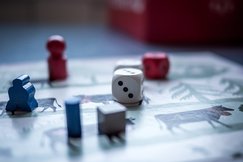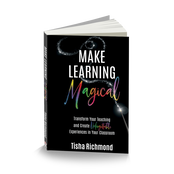 When I began gamifying my classes almost 5 years ago, I had no idea of the amazing adventure it would take me on. The immersive learning environment that has been created by this new way of teaching and learning has transformed my classroom into one that is bursting with creativity, collaboration, problem solving and critical thinking. I truly can't imagine going back to the way I taught class before. However, I remember how I felt before I began this transformation....I was overwhelmed. For those who are feeling that way too, let me give you some advice that helped me get started on this extraordinary journey. WHAT IS GAMIFICATION? First of all, gamification doesn't mean you start from scratch redesigning your curriculum. When you gamify, you are layering the motivational elements of games over your curriculum to create a more immersive learning environment. However, that doesn't mean you are just tacking on XP points or badges. Gamification is creating a rich experience where learning truly comes alive for your students. It's rigorous and challenging, and yet so fun that your students will run into class with anticipation of what the day will bring. READ THIS BOOK! The book Explore Like a Pirate, by Michael Matera is a MUST read! He has written a book that will walk you through each step of gamification in detail with the what, why, and hows. You will find that his philosophy of gamification is far beyond points and badges, but a transformational way to look at learning that will change your teaching forever. This brand of gamification shifts the conversation away from grades and instead empowers students to take hold of their learning and leave a legacy. You will read through the book once and then refer to it time and time again for additional ideas as you expand your game. I also recommend his website Explorelikeapirate.com offering numerous blogs, vlogs, and other resources to help you every step of the way on your journey. In addition, the Explore Like a Pirate Twitter chat on #XPLAP Tuesday 8EST is an awesome opportunity to connect with a community of educators that never cease to amaze me with their ideas and inspiration. START SMALL You don't have to completely gamify your entire class from the get-go. Start with a unit that you would like to revamp. Maybe it's one that you really don't enjoy teaching or has lost it's excitement. What could you do to breathe life into it for you and your students? When I first began, I decided to just gamify a singleton class for one quarter. I felt like this was a manageable place to start. Maybe this is still too overwhelming...is there a lesson that you could gamify instead? THEME I still remember the advice author of Explore Like a Pirate, Michael Matera, gave me before I dove into this adventure. He said, "start with a theme and then everything will start falling into place". This advice has rung true in every unit and class I have gamified. Think of an overarching theme that you could layer over your existing curriculum. The very first time I gamified, it just so happened that I was going to be gone for a 3 day conference and was planning to show the movie "The 100 Foot Journey" that connected to standards we were going to be learning in class. When thinking about the storyline, I realized it could be a great theme for my culinary arts class. In the movie, the main character is chasing after his passion for cooking and is on a mission to earn 3 Michelin stars in the process. I had found my starting point! Students would be on a quest for 3 Michelin stars! GAME DESIGN Just as Michael had suggested, once I chose my theme everything truly did begin falling into place. I now could start developing my story by creating characters, a setting, and action. Students formed into teams and chose restaurant names. I added in action by creating challenges that allowed students to engage in the content in innovative and collaborative ways. I added in game mechanics by developing badges such as, "Restaurant Inspector" and "Restaurant Critic". I planned impromptu inspections and restaurant critics would visit and award students badges for the kitchens that were the cleanest or finished recipes that were the best quality. Badges were given different point values and students had to reach a certain amount before they earned each Michelin star. Badges and points were tracked on a huge piece of butcher paper I had up on my bulletin board. Students loved to come into class each day and see where they were in the game and how close they were to the next star. The element of intrigue and surprise as I developed individual and group challenges created a very fun, engaging, yet rigorous learning atmosphere. The best part was I was having fun too! I had a blast coming up with twists in the game and ideas to keep students excited. I created many opportunities for students to earn badges that appealed to different personality types and motivations. This encouraged all students and motivated even the least engaged. DON'T FIGURE IT ALL OUT FROM THE BEGINNING It's important to understand that I didn't have this all figured out from the beginning. It was a work in progress and I developed as I went. If I would have waited till it was all planned and perfect, it would have never happened. Honestly, even if it was planned out most likely I would have made changes. Your students will guide you as they respond to the game. You will find that seeing your student's enthusiasm is addicting and that you will continually be looking for ways to add in game mechanics. I'M A BELIEVER After just one quarter of gamifying my classroom, I was hooked. I knew that this was something that I needed to develop further. The degree of collaboration, problem solving, critical thinking and creativity that was happening was exciting. Students were more motivated to learn than I'd ever witnessed before and were doing more than was even required to earn their Michelin Stars. I loved that they were learning and having fun in the process! When that quarter ended, I knew that this was just the beginning. The following year, I expanded my gamification to Culinary Arts 3 first semester and by 2nd semester I had gamified all of my Culinary 2 classes as well. I am now well into my second year of gamifying my classes and let me tell you, I have so many adventures to share. Stay tuned as my adventures unfold in the days ahead.
4 Comments
Nicole
2/9/2017 08:45:23 am
I love this post! I really want to try implementing this into one of my classes. Thanks for sharing!
Reply
Kelleigh Ratzlaff
2/9/2017 09:38:40 am
This is so exciting to me! I'll be a first year Culinary teacher in the fall, and I've been looking for ideas. Can't wait to hear more about this, and thanks for the book recommendation, too!
Reply
4/27/2017 10:41:57 pm
When we travel culinary and want to determine where to eat, of course we are faced with several options. In order not to disappoint in choosing, we must have a trick in determining it. For example, when we are in a new place and still strange. The stomach is already hungry because of the activities of the roads that drain energy. We can see a good place to eat from the atmosphere. If the place to eat is a lot of visitors, it can be ascertained this place has the advantage that many people in demand. We need to try if it is time for hunger.
Reply
Susan Keller
10/6/2019 07:30:57 pm
I would like to subscribe to my home email, even though I already have to my school one. Is that ok? This looks like something I want to use!
Reply
Your comment will be posted after it is approved.
Leave a Reply. |
Tisha RichmondStudent Engagement & PD Specialist in Southern Oregon, Canva Learning Consultant, Canva Education Creator, and author of Make Learning Magical. I'm passionate about finding innovative ways to transform teaching and create unforgettable experiences in the classroom. |
- HOME
- SPEAKING
- ABOUT ME
- BLOG
-
RESOURCES
- Memorable Beginnings >
- Authenticity & Agency
-
Gamified Experiences
>
- Anywhere Learning Plans
- The Amazing Race Game Plan Resources
- The Race to the Golden Ticket
- Ready Player One
- The Amazing Food Truck Race
- The Great Interior Design Challenge
- The Final Table Challenge
- Challenge Rubrics
- Challenge Ideas
- Kitchen Utensil Race & Other Variations
- Code Names for the Classroom
- Badges
- Innovation
- Creativity, Curiosity, and Collaboration
- Authentic Audience
- Legacy
- Make Learning Magical Book
- PODCAST
- T-SHIRTS
- YOUTUBE
-
RECIPES
- Workshop & Session Resources
- Dragon Smart Reviews
Proudly powered by Weebly



 RSS Feed
RSS Feed